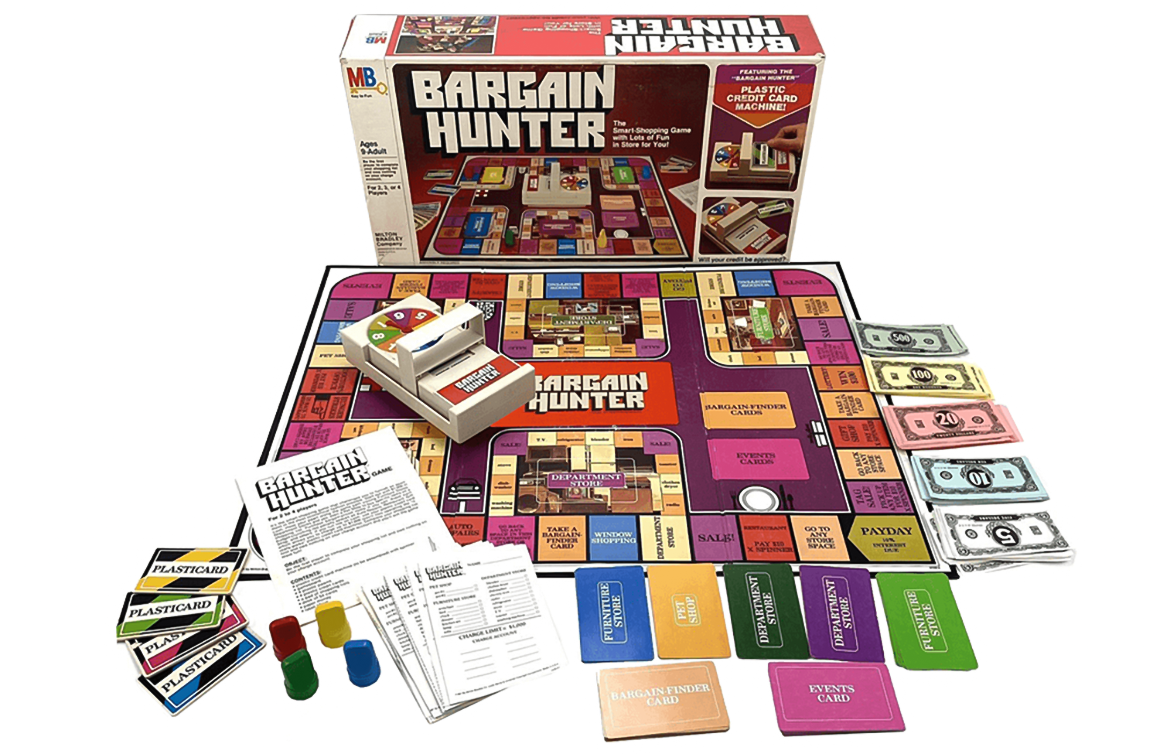“Are you ready to test your inflation-fighting skills in the marketplace?”
Released in 1981, the Bargain Hunter board game from Milton Bradley offered players as young as nine the chance to recreate the experience of furnishing a home, hunting for deals, using credit cards, and managing debt.
GAMEPLAY
The object of the game was to furnish an apartment in the most budget-friendly manner. This was accomplished by moving along the game board and stopping to acquire household items on a pre-printed shopping list. There were 5 stores on the board: 1 pet shop, 2 furniture stores, and 2 department stores.
Each player began with $1,000 in cash and a credit card with a $1,000 limit. The person with the highest spin started the game and served as the game’s banker.
Players moved their pawns according to the number indicated on the spinner. At designated stops along the board, players entered stores to do their shopping. Items could be bought for cash or credit.
Players were required to purchase the following items for their apartment: 2 pets; an armchair, bed, desk, dresser, kitchen set, lamp, and sofa; and a blender, washing machine, clothes dryer, dishwasher, iron, radio, refrigerator, stove, television, and toaster. Prices were included on price cards located in each store. Players could choose to pass on a purchase if they felt it was too expensive and could find a bargain with some luck during a future turn.
In addition to domestic purchases, red “penalty” stops on the board unexpectedly separated players from their money. Such stops had players paying for life events including auto repairs, birthday gifts, visits to the doctor’s office, and other out-of-pocket expenses. Yet other spaces included Window Shopping, Sale, Pay Day, and more, adding to the dynamics of the game.
Bargain-Finder cards afforded players extra moves, discounts, and other perks. Event cards allowed players to receive a benefit in the form of a sale or by penalising an opponent with an unwelcome trip to a restaurant.
Players could opt to use credit to make a purchase. They declared the amount they wanted to borrow, placed their credit card on the machine, and slid the handle back and forth to “process” the transaction. Credit could be approved or declined.
The first player to complete their shopping list and have a zero balance on their credit card won the game.
IN THE BOX
A complete game included the game board, plastic credit card machine with spinner, 4 pawns, 4 plasticards (credit cards), a pad of shopping lists, 17 bargain-finder cards, 17 event cards, 20 price cards (4 cards for each store), paper money, and a label sheet. An instruction booklet was also included.
Watch a classic commercial for Bargain Hunter on the Toy Tales YouTube channel.
Note: If you buy something using the eBay link in this story, we may earn a small commission. Thank you for supporting independent toy journalism!

